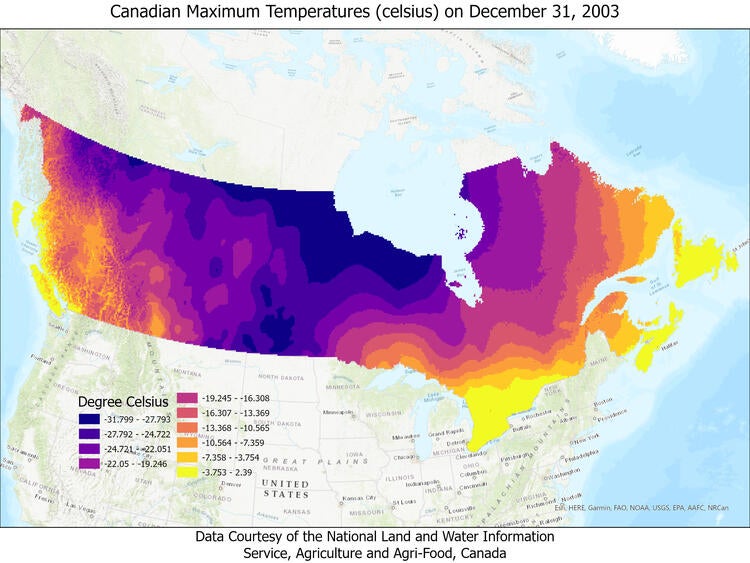Contact the Geospatial Centre
Dana Porter Library, Room 328
University of Waterloo Library
Waterloo, Ontario N2L 3G1
Email: librarygeo@uwaterloo.ca
This dataset was received from the National Land and Water Information Service, Agriculture and Agri-Food, Canada.
For current downloadable datasets, please visit: https://climatedata.ca/.
The Daily 10 km Gridded Historial Climate Dataset for Canada 1961-2003 (ANUSPLIN Point Grid) contains gridded point locations of daily maximum temperature (°C), minimum temperature (°C), and precipitation (mm) for the Canadian landmass south of 60°N . Each daily grid contains interpolated point estimates arranged in a regular grid with a spacing of 10 km. Grids were interpolated from daily Environment Canada climate station observations using a thin plate smoothing spline surface fitting method implemented by ANUSPLIN V4.3.
The data are georeferenced TIF images, one image for each day of the year.
These data sets are available in Geographic Coordinate System, Horizontal Datum: North American Datum (NAD) 83. Map projection name: Albers Conical Equal Area. Other data formats can be accommodated, as the Geospatial Centre has access to a number of conversion utilities.
To request this data, please fill out the Ask-Us form and include which layers (shapefiles) you are interested in obtaining. The dataset will be shared with you via OneDrive upon completion of the data release agreement form. You may also make an in-person appointment using the same form. You can also go to https://climatedata.ca/
This material is provided for academic, research, teaching, and personal use only. National Land and Water Information Service, Agriculture and Agri-Food, Canada should be acknowledged on any derivative product, such as a map or an image.
Daily Maximum Temperatures (celsius) for Canada. [Computer File]. National Land and Water Information Service, Agriculture and Agri-Food, Canada, 2020.

Dana Porter Library, Room 328
University of Waterloo Library
Waterloo, Ontario N2L 3G1
Email: librarygeo@uwaterloo.ca
The University of Waterloo acknowledges that much of our work takes place on the traditional territory of the Neutral, Anishinaabeg, and Haudenosaunee peoples. Our main campus is situated on the Haldimand Tract, the land granted to the Six Nations that includes six miles on each side of the Grand River. Our active work toward reconciliation takes place across our campuses through research, learning, teaching, and community building, and is co-ordinated within the Office of Indigenous Relations.